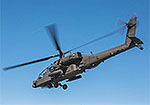First Apaches arrive in Alaska as Army reorganizes
 The first of 24 AH-64 Apache helicopters were scheduled to arrive Tuesday in Alaska as part of the Army’s sweeping five-year reorganization of its aviation assets.
The first of 24 AH-64 Apache helicopters were scheduled to arrive Tuesday in Alaska as part of the Army’s sweeping five-year reorganization of its aviation assets.
The Apaches, which were coming from Germany, were being delivered via an Air Force C-5 Galaxy, landing Tuesday afternoon local time at Ladd Army Airfield on Fort Wainwright.
The Apaches will be assigned to U.S. Army Alaska’s Aviation Task Force, which already has UH-60 Black Hawks and CH-47 Chinooks.
The helicopters will eventually be part of the 1st Attack Reconnaissance Battalion, 25th Aviation Regiment, 25th Infantry Division. The battalion, a new unit, is scheduled to be activated in September, said Lt. Col. Alan Brown, a spokesman for U.S. Army Alaska.
The battalion’s full complement of 24 Apaches is expected to be in place by April, and they will be housed and maintained at Ladd Army Airfield, Brown said.
Soldiers for the unit have already begun to arrive, and they will continue to flow in through March, Brown said.
“The Apache provides U.S .Army Alaska a very capable attack and reconnaissance aircraft that can be used to support joint, multi-component training and operations here in Alaska or be deployed rapidly … to support partnered operations across the Pacific,” Brown said.
The Apache is the Army’s primary attack helicopter. The twin-engine, four-bladed, multi-mission aircraft was designed to fight close and deep to destroy, disrupt or delay enemy forces.
The Apache is manned by a two-person crew, and it can carry up to 16 Hellfire laser-designated missiles. It also can employ a 30mm M230 chain gun and Hydra 70 rockets, according to the Army.
The arrival of Apache helicopters as well as the Gray Eagle Unmanned Aerial System in Alaska will give the Army “world-class training opportunities in support of the Army and joint force,” said Col. John Lindsay, director of Army aviation.
“The Aviation Restructure Initiative has enabled the Army to more rapidly develop and refine manned-unmanned teaming, which will continue to give our soldiers an unfair advantage anywhere they fight,” he said.
The first two Apaches arriving in Alaska are coming from Germany, which is home to the 12th Combat Aviation Brigade. The rest of the Apaches will “be resourced from multiple locations across the active Army,” Brown said.
The Army in April announced it would restructure the 12th CAB, cutting about 1,900 military positions and about 2,850 family members from Germany by September 2016.
The brigade is not being inactivated, officials said at the time. Instead, the Army will retain a headquarters element of the 12th CAB in Katterbach, Germany, to command all U.S. Army Europe aviation, and the brigade will be augmented by rotational units from the United States.
About 1,900 soldiers will leave Germany as part of the restructure, but about 1,300 will remain by the fall of 2016.
Of those 1,300 soldiers, about 800 will be stationed in Germany while about 500 will be rotational, officials said.
Also being cut from Germany are 24 AH-64 Apaches, 30 UH-60 Black Hawks, three CH-47 Chinooks and nine HH-60 medevac Black Hawks.
The cuts are part of the Army's Aviation Restructuring Initiative, which includes eliminating the OH-58 Kiowa Warrior from the Army's inventory and inactivating the 159th Combat Aviation Brigade from Fort Campbell, Kentucky.
The controversial five-year restructuring initiative also uses the AH-64 Apache to fill the Kiowa's reconnaissance and scout role, requiring the Army to pull Apaches from the National Guard inventory to fill the gap. The Army, in turn, would provide the Guard with UH-60 Black Hawk helicopters, a move that has been decried by Guard advocates.
Overall, the cuts are part of a series of reductions the Army is making as it draws down to an end-strength of 490,000 by Sept. 30. The Army has announced 13 brigade combat team inactivations and a massive restructuring of its remaining BCTs.
Another 40,000 soldiers will be cut beginning in October through the end of fiscal year 2018. The accompanying force structure cuts, to include reducing two BCTs to battalion-sized task forces, are scheduled to be completed by the end of fiscal 2017.